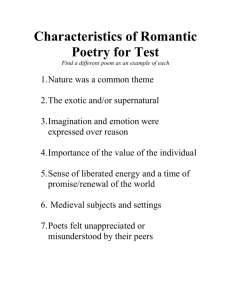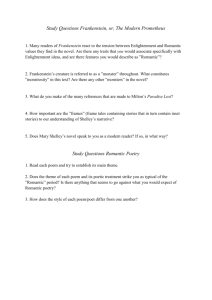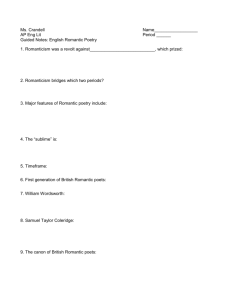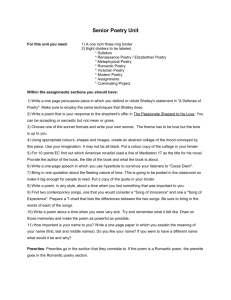The Romantic Period
advertisement
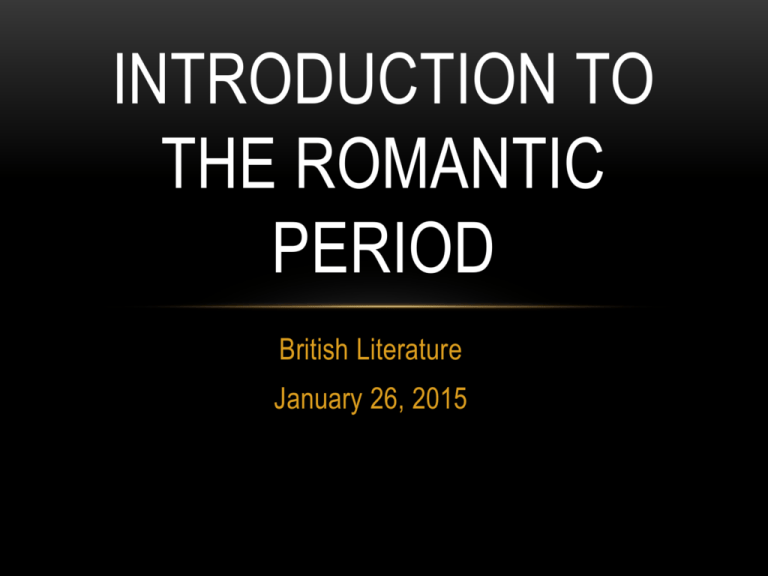
INTRODUCTION TO THE ROMANTIC PERIOD British Literature January 26, 2015 CLASS ENTRANCE TO-DO LIST • Turn in the following: • Hamlet Literary Elements • Hamlet Character Chart (extra credit) • Pick up the following: • Wuthering Heights Reading Schedule & Annotation Expectations Bookmark • Hang up your Hamlet Irony Assignment somewhere in the room with your name in a visible place ON THE CLOCK WALL using tape. • Sign up for your Poetry Research project. HAMLET IRONY ASSIGNMENT GALLERY WALK • Go around the room to admire your classmates’ work. As you walk around the room, you must post three sticky notes: • Comment on your classmates’ ideas, artistry, or quotes. You may also ask questions of your classmates’ poster. • You only have 5-7 minutes to complete this gallery walk. Influence of the Revolution History of the Times • Because the French king has been overthrown by a democratic mob, the French Revolution is radical and frightening to English ruling classes. • English conservatives worry that revolutionary fever will cross the Channel to England. • Until the violence and terror escalate, English liberals support the French Revolution’s ideals of “liberty, fraternity, equality.” Revolution Spreads Literature of the Times • In reaction to the ugliness and turmoil of the times, writers turn to nature, the past, and a dream world of imagination. • Romantic period begins in 1798 as a response to the Industrial Revolution. ROMANTIC POETRY Literature of the Times The Romantic poets • were dedicated to political and social change • believed in the power of literature • thought imagination—not reason—was the best response to forces of change • created private, spontaneous lyric poetry THE ROMANTIC PERIOD Literature of the Times • Romantic literature was dominated by poetry. • Romantics thought poets were extraordinary people, necessary to humanity and society. • Keats called poets “physicians,” Blake called them teachers, and Shelley thought they were the “unacknowledged legislators of the world.” • The novel also thrived, however. Key novelists included Jane Austen, Maria Edgeworth, and Sir Walter Scott. INDUSTRIALIZATION History of the Times • England is the first nation to experience the effects of the Industrial Revolution. • Swelling urban populations create desperate living conditions. • The era’s misery and poverty are justified by an economic policy called laissez faire (business independent from government). THEMES OF ROMANTIC POETRY Influences on Romantic Poetry • Spread of democratic ideals through the American and French Revolutions and disillusionment after failure of French Revolution • Reactions against harsh living and working conditions created for urban poor by the Industrial Revolution • Fascination with nature and country life, which seemed a blissful retreat from city slums THEMES OF ROMANTIC POETRY A New Focus in Poetry • Invited readers to feel power and passion • Tried to capture personal experience Restoration Era Romantic Period • Society needed social change. • Poets wrote about • Poets celebrated order, personal feelings, hierarchy, and enlightened rule. individual rights, and used everyday language. • Order had just been restored. THEMES OF ROMANTIC POETRY Imagination: The Inspired Guide The Romantics saw imagination as the link between mind and nature. • To them, imaginative experiences were especially moving, perhaps superior to human reasoning. • The mysterious forces of Nature inspired them. THEMES OF ROMANTIC POETRY Nature: The Wise Teacher The Romantics’ interest in natural images and themes was reflected in Gothic literature. Novels such as Mary Shelley’s Frankenstein appealed to the imagination through Eerie settings Supernatural events Questions about humans’ ability to manipulate nature THEMES OF ROMANTIC POETRY Experience: The Worthy Subject Romantic poets favored idealized rural settings. However, some celebrated the people who lived in crowded cities. They promoted rights to Healthful living conditions Relief from political or economic oppression Self-expression THEMES OF ROMANTIC POETRY Experience: The Worthy Subject Some Romantics dreamed that poetry could offer an example of model behavior to improve horrific social conditions: Undemocratic governments Dangerous factories Child labor Laissez-faire economic policies that left businesses unregulated Child workers in coal mine TP-CASTT METHOD Happy Mechanics Monday! When you read a poem closely, try this method: T is for TITLE •Analyze the title first. •What do you predict this poem or work will be about? •Write down your predictions. •We will reflect on the title again after we have read the poem. •The next step is often omitted, but it is the most important! P is for PARAPHRASE • Paraphrasing is putting something in your own words. • After reading the poem, rewrite it in your own words. • This may be three sentences or a page, depending on the particular poem. C is for CONNOTATION •Analyze the figures of speech and sound effects of the poem. •Look at the connotations of words (connections and associations) •Examine any literary elements A is for ATTITUDE Tone is the attitude of the speaker toward the subject of the poem. Don’t Confuse Tone & Mood! • Tone is the author's or the poet's attitude towards his or her subject. • Mood is how the poem makes a reader feel. • Therefore, the tone in the Psalm would be David’s attitude in the text. S is for SHIFT •If there is a change in… –Time –Tone –Mood –Speaker This should always be noted as this will also affect the meaning. T is for TITLE (again) •At this time, you should reconsider the title. •Were you right in your predictions? •What other meanings might the title have in light of your analysis? T is for THEME •As you already know, theme is the general insight into life conveyed by the author through his/her work. •It merely states something that is true to life and the human condition. •Write a thematic statement: – STEP ONE: Choose an important topic in the poem. – STEP TWO: Write what the work conveys or says about that topic. How do I find the THEME? •Look at the other parts of TPCASTT. •What insight are all of these working together to convey? •What is the poet trying to say about life? ROMANTIC POETRY RESEARCH, ANALYSIS, AND PRESENTATION • For this project, you will be assigned a poem from the Romantic period of British Literature. • You will research the poet and the poem. • You will closely read and engage the poem using several strategies, specifically the TP-CASTT method. Complete the TP-CASTT chart on the back of the assignment sheet. • Then, you will prepare a presentation to the class to discuss your poem. PROJECT EVALUATION
